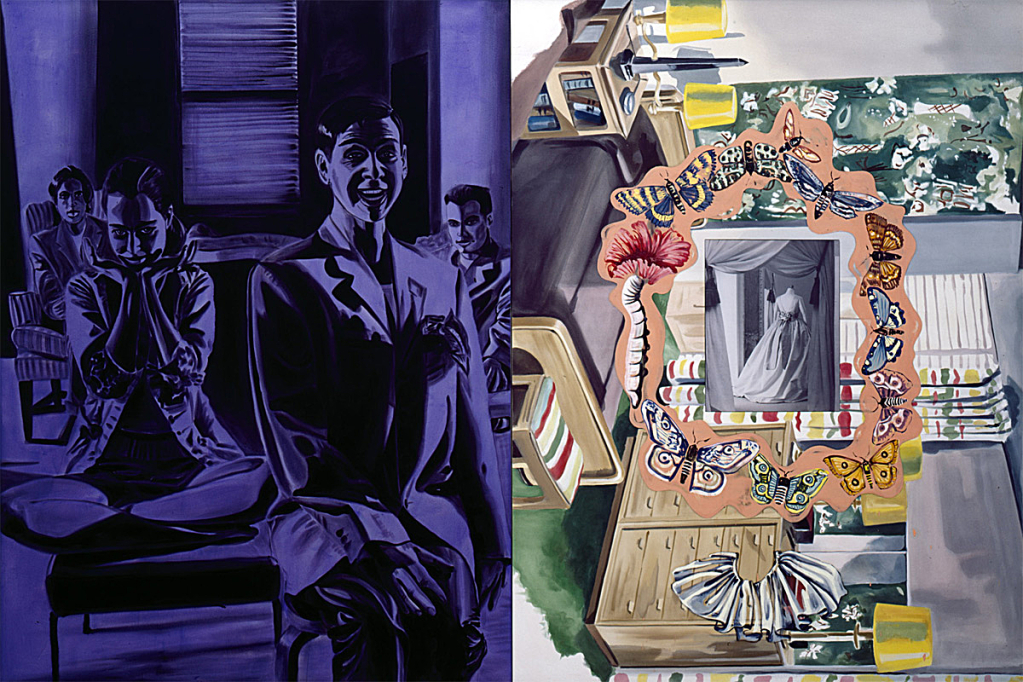David Salle
01.18.2000 - 05.14.2000
David Salle is one of the most significant American artists to have emerged in the early 1980s. His unique style of painting was influential in the international revival of large-scale, figurative painting that characterized much of the artistic production of this decade. Organized by the Stedelijk Museum, Amsterdam, this broad retrospective spans twenty years of the artist's career from approximately 1980 to the present.
Salle, who lives and works in New York, grew up in the Midwest of the United States. In the 1970s he attended the newly established California Institute of the Arts, where he began applying film techniques, such as montage and split screen, to painting. After completing school, Salle moved to New York, where his complex, visually stimulating imagery quickly attracted the attention of the 1980s international art audience.
The artist, like many of his generation, turned to found images as inspiration for much of his rich visual vocabulary. In appropriating scenes from art history, advertising, design, and popular culture, Salle creates an assemblage of mixed cultural references. In his paintings we can find allusions to artworks by Baroque artists Velázquez and Bernini, the Post-Impressionist painter Cézanne, the Surrealists Giacometti and Magritte, and the postwar American artist Jasper Johns. In addition to the fine arts, Salle also borrows from the erotic and decorative arts. We often see painted representations of sexualized female figures the artist photographed in his studio as well as depictions of objects and interiors he copied from various sources. These scenes are sometimes juxtaposed with three-dimensional objects of design including tables, patterned fabric, and bottles or superimposed with disparate names and titles from literature and film, such as Tennyson or King Kong.
Salle's work is emblematic of what has been termed postmodern. If the protagonist of modernism was self-reflexive, the postmodern artist seeks transcendence in a fragmented material world. Salle draws from this world and creates another in which the original contexts of images and styles recede like distant memories. In his paintings narrative conventions are neutralized and subverted. Finally, his paintings are visual events that insist on the primacy of seeing, and whose purpose is to access emotion.
In addition to the paintings seen in this exhibition, Salle's diverse output includes sculpture, the feature film Search and Destroy, and set designs for punk-inspired ballets choreographed by Karole Armitrage.
Since the 1980s, David Salle has continued to challenge himself and the international art audience. In the 1990s he experimented with developing several different series of works, often at the same time.
Salle began the nineties with his Tapestry Paintings, for which he borrowed patterns from 17th-century Italian and Russian tapestries to produce this body of work. His handling of paint over the coarse canvases gives each painting the look and feel of woven fabric. Unlike much of his previous works made up of diptychs or triptychs, these paintings are each composed of a single overall tableau within which small inset images have been strategically placed as a means to break up the original composition and meaning of the tapestry. Other images, such as cartoon bubbles and Bunraku puppet heads, further disrupt the narrative while adding a comedic element to these reconstructed scenes. By comparison to his depictions of the female form in the 1980s, the women in the inset grisaille panels are often costumed as harlequins or other characters. Their sexual provocation is reduced, but not completely diminished.
In 1993, Salle created his Early Product Paintings, including Exit Laughing, which recalls the work of American Pop painter James Rosenquist through its interwoven advertisements of liquor, household appliances, and cigarettes. At about the same time, Salle also developed a series of Ballet Paintings, whose backgrounds are based on 1950s photographs of Paris Ballet stars rehearsing and which demonstrate his most loosely gestural brushwork to date.
Salle's recent work focuses on bears, interiors, glass, and mirrors. In comparison to his previous work, these paintings are generally more colorful and have fewer photographic-based elements. In addition, many of the inset panels are no longer rigidly rectangular or oval, but curved or star shaped. As Salle matures as an artist, he continues to fascinate us as he develops and reinvents his imagery in new ways. Throughout his career Salle has created an intuitive shifting style that, while constructed from many sources, is immediately recognizable and distinctly his own.
Craig Houser
Assistant Curator
David Salle
Comedy, 1995
Acrylic and oil on canvas
243,8 x 365,8 cm
Solomon R. Guggenheim Museum, New York
Purchased with funds contributed by the International Directors Council; Mr. and Mrs. Edward V. Shuffro; The Eli Broad Family Foundation; and Rachel Lehmann

